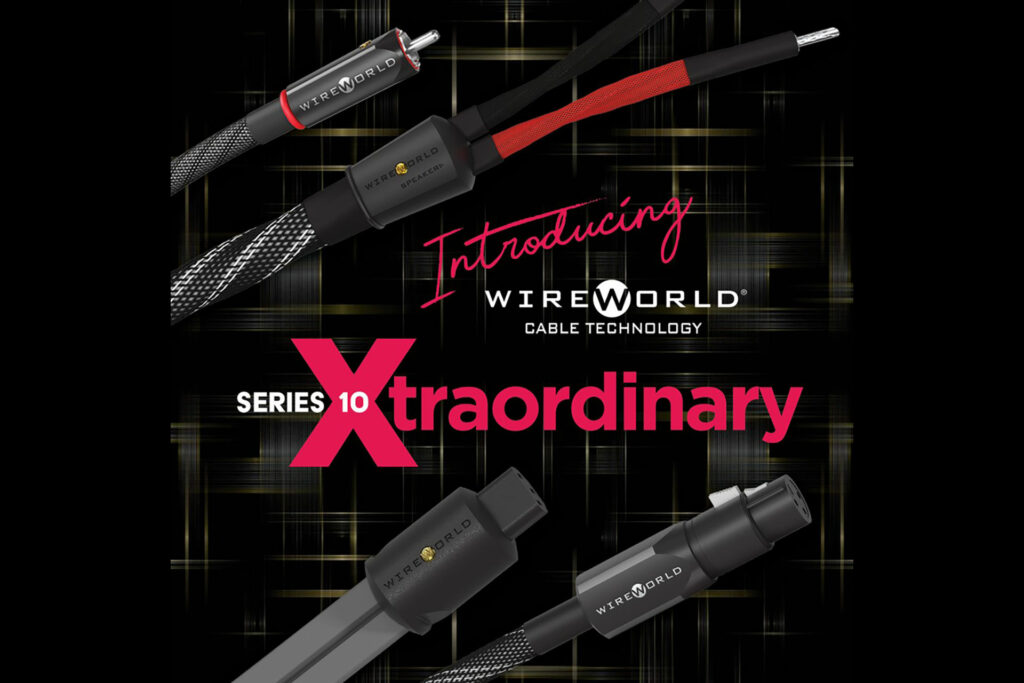Wireworld Cable Technology, one of the world’s most respected brands of high-performance audio and video cables, is introducing their next generation ‘Series 10’ audio cables. These new cables incorporate several technical and visual improvements over the previous ‘Series 8’. The patented DNA Helix designs have been upgraded with additional strand groups that reduce electromagnetic (eddy current) losses for increased resolution, focus and dynamic contrast. Wireworld’s latest composite insulation technology, COMPOSILEX® 5, minimizes triboelectric noise to provide cleaner sonic textures and quieter backgrounds than previous insulation materials. These material and design upgrades represent five years of additional research and development beyond Wireworld’s critically acclaimed Series 8 cables.

The Series 10 cable line includes a wide selection of audio interconnects, loudspeaker cables, power cords, 75-Ohm and 110-Ohm digital audio cables. There are nine levels of audio interconnects priced from $36 to $3900 per pair. The interconnect range includes five levels of tonearm cables, subwoofer cables and minijack cables. The six levels of 75-Ohm coaxial digital cables are priced from $40 to $2000 for the 1m length. There are four levels of 110-Ohm balanced digital cables priced from $210 to $1850 for a 1m cable. The twelve speaker cables range in price from $1.50 to over $1000 per foot. The outstanding ability of these cables to minimize sonic artifacts and masking effects makes them especially helpful in getting more lifelike sound from basic home music systems to all-out high-end mastering studios.
Wireworld calls their power cords ‘Power Conditioning Cords™’ because they are designed to extend the functions and benefits of power conditioning all the way to the component’s power inlet. With five levels of three-conductor cords starting at $130 and two levels of ‘Figure-8’ two-conductor cords starting at $70, their proprietary Fluxfield™ designs provide highly effective shielding and filtering. The Series 10 upgrade to COMPOSILEX® 5 insulation dramatically increases the filtering abilities of the Fluxfield™ designs.
The Audiophile History of Wireworld Cables
Wireworld is one of the most established names in the world of audiophile cables, and it didn’t get there by leaning into marketing gimmicks or pseudo-scientific jargon. The brand’s legacy is rooted in engineering, research, and a willingness to challenge long-standing assumptions about how signal transfer happens in audio systems. At the center of that story is David Salz, Wireworld’s founder and chief designer—an audio obsessive who decided early on that if he was going to make cables, they had to prove their worth not just by ear, but by measurement and comparison.
The Wireworld story starts in the early 1990s, during a period when high-end audio cables were becoming more visible, more expensive, and—depending on your view—more controversial. The market was filled with brands claiming night-and-day improvements, often without much explanation. Salz wasn’t having it. His approach was straightforward: develop cables that were demonstrably more transparent, using controlled tests, repeatable metrics, and a deeper understanding of electromagnetic behavior.
Rather than relying on listening alone, Salz developed what he called the “Cable Comparator”—a system that allowed A/B comparisons between a direct connection and a cable connection in real time. This setup eliminated memory bias and delayed perception, letting listeners (and himself) evaluate how much, if anything, a cable was adding or taking away from the source signal. Through this method, he learned that even short lengths of cable could subtly—but measurably—affect sound.
From that foundation, Salz developed Wireworld’s DNA Helix design—an approach that reduces electromagnetic loss and preserves phase integrity by controlling the geometry of the conductors with extreme precision. The idea was to move beyond typical twisted-pair or coaxial designs and create cable structures that actually behaved more like a direct connection electrically. This attention to geometry, conductor material, and insulation became the core of the Wireworld design philosophy.
One of the key differences with Wireworld cables is their flat, ribbon-like shape, which isn’t just a design choice—it’s functional. The geometry is optimized for signal transfer, and in higher-end models, the conductor materials include OCC (Ohno Continuous Cast) copper and silver-clad variants, which offer extremely high conductivity and low distortion at audio frequencies.
Wireworld began with analog interconnects and speaker cables, and quickly built a reputation for producing clean, neutral-sounding cables that didn’t hype or dull the system. But the company’s real breakout came when they started applying the same rigor to digital cables—AES/EBU, coaxial, USB, HDMI, and even Ethernet. While many audiophiles dismissed digital cable design as irrelevant (“it’s just ones and zeroes”), Salz approached it from the standpoint of timing, jitter, and signal integrity. He argued that minimizing loss and reflections in the cable could reduce error correction activity, leading to cleaner, more consistent digital playback. Whether or not you buy into the full theory, the results spoke for themselves—many listeners heard tangible differences when switching to Wireworld digital cables, especially in resolving systems.
In the last two decades, Wireworld has expanded its lineup into nearly every major cable category: power cords, HDMI, USB, Ethernet, optical, tonearm cables, and even headphone cables. But the consistency has been in the voicing—neutral, open, and engineered to preserve what’s upstream without editorializing.
Wireworld doesn’t make “flavor” cables. They’re not designed to warm up a bright system or soften harsh digital edges. They’re designed to get out of the way, revealing what your components are actually doing. That’s not a marketing slogan—that’s David Salz’s design brief, and it’s one that hasn’t changed much since the early ’90s.
The brand also avoids the kind of hyperbole that turns off rational listeners. Wireworld doesn’t talk about cables as “components” or lean into magic dust theories. Instead, they publish test data, show waveform comparisons, and invite skeptics to listen for themselves. In a space where credibility can be hard to maintain, that engineering-first transparency has kept them relevant.



